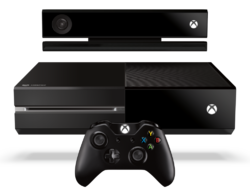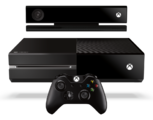Xbox One
From Halopedia, the Halo wiki
The Xbox One is Microsoft's upcoming eighth generation game console and and the successor to the Xbox 360.[1] It was first revealed to the public during Microsoft's keynote conference at E3 on May 21, 2013. During development, the Xbox One was codenamed Project Durango. The Xbox One is scheduled for release in November 2013 and will directly compete with Sony's PlayStation 4 and Nintendo's Wii U as part of the eighth generation of video game consoles, retailing at $499 USD (£429 GBP).
Microsoft call the device an "all-in-one entertainment system," placing an increased emphasis on entertainment using an updated Kinect peripheral and offering the ability to use an existing set-top box to watch live TV (using the new Kinect as a voice controller), a built-in Skype application, and improved support for dual screens. The console also provides new in-game functionality, such as an expanded Xbox Live service, improved Kinect functionality, cloud computing, the ability to automatically record and share video highlights from gameplay, and integrated support for live streaming gameplay online. Initial reaction to the Xbox One was mostly negative. Early reviews praised the console's new features, while others had criticized its lack of backwards compatibility with Xbox 360 games, online connectivity requirements, mandatory integration with Kinect, and ambiguous restrictions on the resale and sharing of used games. In response to consumer feedback, Microsoft announced that the originally planned digital rights management and internet connection requirements would no longer be attached to the Xbox One.
The Xbox One features a two-tone "liquid black" finish; with half finished in a matte grey, and the other in gloss black. The design of the Xbox One's components were designed to evoke a more entertainment-oriented and simplified design than previous iterations of the console; among other changes, the LED rings used by the Xbox 360 are replaced by a glowing white Xbox logo used to communicate the system's status to the user.
The Xbox One has an APU with eight x86-64 cores, 8 GB of DDR3 RAM with a memory bandwidth of 68.3 GB/s,[25] a 500 GB non-replaceable hard drive, and a Blu-ray disc drive. The graphics processing unit (GPU) is based on an AMD GCN architecture with 12 compute units, which have a total of 768 cores, providing an estimated peak theoretical power of 1.23 TFLOPS. For networking, the Xbox One supports Gigabit Ethernet. 802.11n wireless, and Wi-Fi Direct.
The Xbox One will support 4K resolution (3840×2160) video output and 7.1 surround sound. The Xbox One will support HDMI 1.4 for both input and output. The Xbox One does not have a video output for either composite or component video.


